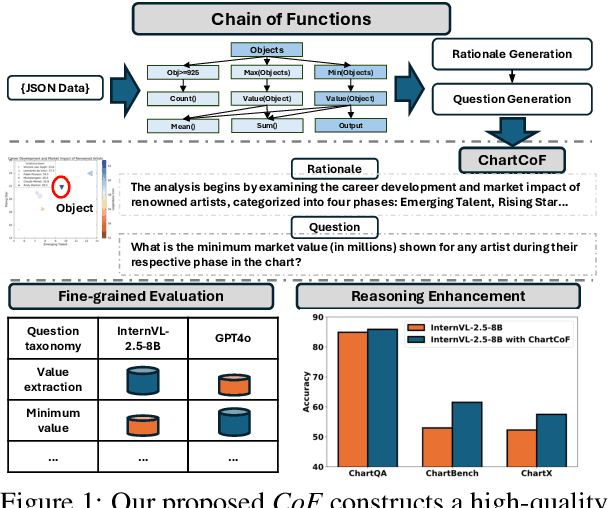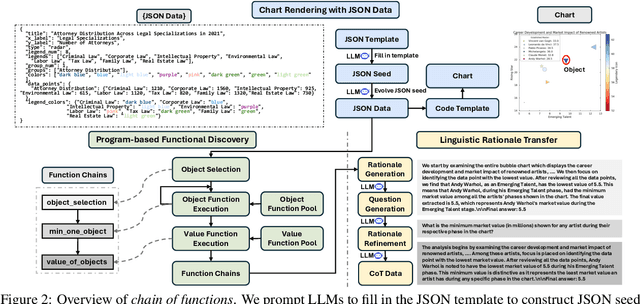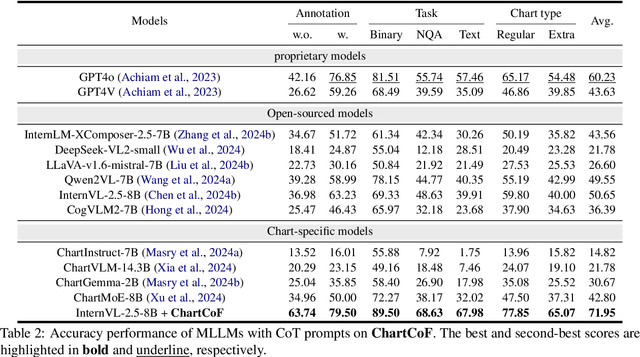Zijian Li
Thought Communication in Multiagent Collaboration
Oct 23, 2025Abstract:Natural language has long enabled human cooperation, but its lossy, ambiguous, and indirect nature limits the potential of collective intelligence. While machines are not subject to these constraints, most LLM-based multi-agent systems still rely solely on natural language, exchanging tokens or their embeddings. To go beyond language, we introduce a new paradigm, thought communication, which enables agents to interact directly mind-to-mind, akin to telepathy. To uncover these latent thoughts in a principled way, we formalize the process as a general latent variable model, where agent states are generated by an unknown function of underlying thoughts. We prove that, in a nonparametric setting without auxiliary information, both shared and private latent thoughts between any pair of agents can be identified. Moreover, the global structure of thought sharing, including which agents share which thoughts and how these relationships are structured, can also be recovered with theoretical guarantees. Guided by the established theory, we develop a framework that extracts latent thoughts from all agents prior to communication and assigns each agent the relevant thoughts, along with their sharing patterns. This paradigm naturally extends beyond LLMs to all modalities, as most observational data arise from hidden generative processes. Experiments on both synthetic and real-world benchmarks validate the theory and demonstrate the collaborative advantages of thought communication. We hope this work illuminates the potential of leveraging the hidden world, as many challenges remain unsolvable through surface-level observation alone, regardless of compute or data scale.
WebWeaver: Structuring Web-Scale Evidence with Dynamic Outlines for Open-Ended Deep Research
Sep 16, 2025



Abstract:This paper tackles open-ended deep research (OEDR), a complex challenge where AI agents must synthesize vast web-scale information into insightful reports. Current approaches are plagued by dual-fold limitations: static research pipelines that decouple planning from evidence acquisition and one-shot generation paradigms that easily suffer from long-context failure issues like "loss in the middle" and hallucinations. To address these challenges, we introduce WebWeaver, a novel dual-agent framework that emulates the human research process. The planner operates in a dynamic cycle, iteratively interleaving evidence acquisition with outline optimization to produce a comprehensive, source-grounded outline linking to a memory bank of evidence. The writer then executes a hierarchical retrieval and writing process, composing the report section by section. By performing targeted retrieval of only the necessary evidence from the memory bank for each part, it effectively mitigates long-context issues. Our framework establishes a new state-of-the-art across major OEDR benchmarks, including DeepResearch Bench, DeepConsult, and DeepResearchGym. These results validate our human-centric, iterative methodology, demonstrating that adaptive planning and focused synthesis are crucial for producing high-quality, reliable, and well-structured reports.
Should Bias Always be Eliminated? A Principled Framework to Use Data Bias for OOD Generation
Jul 22, 2025Abstract:Most existing methods for adapting models to out-of-distribution (OOD) domains rely on invariant representation learning to eliminate the influence of biased features. However, should bias always be eliminated -- and if not, when should it be retained, and how can it be leveraged? To address these questions, we first present a theoretical analysis that explores the conditions under which biased features can be identified and effectively utilized. Building on this theoretical foundation, we introduce a novel framework that strategically leverages bias to complement invariant representations during inference. The framework comprises two key components that leverage bias in both direct and indirect ways: (1) using invariance as guidance to extract predictive ingredients from bias, and (2) exploiting identified bias to estimate the environmental condition and then use it to explore appropriate bias-aware predictors to alleviate environment gaps. We validate our approach through experiments on both synthetic datasets and standard domain generalization benchmarks. Results consistently demonstrate that our method outperforms existing approaches, underscoring its robustness and adaptability.
Learn as Individuals, Evolve as a Team: Multi-agent LLMs Adaptation in Embodied Environments
Jun 08, 2025



Abstract:Large language models (LLMs) possess extensive knowledge bases and strong reasoning capabilities, making them promising tools for complex, multi-agent planning in embodied environments. However, despite LLMs' advanced abilities and the sophisticated modular design of agentic methods, existing LLM-based planning algorithms remain limited by weak adaptation capabilities to multi-agent embodied scenarios. We address this limitation by introducing a framework that enables LLM agents to learn and evolve both before and during test time, equipping them with environment-relevant knowledge for better planning and enhanced communication for improved cooperation. Inspired by centralized training with decentralized execution in multi-agent reinforcement learning, we propose a \textit{Learn as Individuals, Evolve as a Team (LIET)} paradigm for multi-agent LLMs adaptation. At the individual level, LLM agents learn a local utility function from exploratory datasets to better comprehend the embodied environment, which is then queried during test time to support informed decision-making. At the team level, LLM agents collaboratively and iteratively maintain and update a shared cooperation knowledge list based on new experiences, using it to guide more effective communication. By combining individual learning with team evolution, LIET enables comprehensive and flexible adaptation for LLM agents. Our experiments on Communicative Watch-And-Help and ThreeD-World Multi-Agent Transport benchmarks demonstrate that LIET, instantiated with both LLaMA and GPT-4o, outperforms existing baselines and exhibits strong cooperative planning abilities.
An Identifiable Cost-Aware Causal Decision-Making Framework Using Counterfactual Reasoning
May 13, 2025Abstract:Decision making under abnormal conditions is a critical process that involves evaluating the current state and determining the optimal action to restore the system to a normal state at an acceptable cost. However, in such scenarios, existing decision-making frameworks highly rely on reinforcement learning or root cause analysis, resulting in them frequently neglecting the cost of the actions or failing to incorporate causal mechanisms adequately. By relaxing the existing causal decision framework to solve the necessary cause, we propose a minimum-cost causal decision (MiCCD) framework via counterfactual reasoning to address the above challenges. Emphasis is placed on making counterfactual reasoning processes identifiable in the presence of a large amount of mixed anomaly data, as well as finding the optimal intervention state in a continuous decision space. Specifically, it formulates a surrogate model based on causal graphs, using abnormal pattern clustering labels as supervisory signals. This enables the approximation of the structural causal model among the variables and lays a foundation for identifiable counterfactual reasoning. With the causal structure approximated, we then established an optimization model based on counterfactual estimation. The Sequential Least Squares Programming (SLSQP) algorithm is further employed to optimize intervention strategies while taking costs into account. Experimental evaluations on both synthetic and real-world datasets reveal that MiCCD outperforms conventional methods across multiple metrics, including F1-score, cost efficiency, and ranking quality(nDCG@k values), thus validating its efficacy and broad applicability.
Causal View of Time Series Imputation: Some Identification Results on Missing Mechanism
May 12, 2025Abstract:Time series imputation is one of the most challenge problems and has broad applications in various fields like health care and the Internet of Things. Existing methods mainly aim to model the temporally latent dependencies and the generation process from the observed time series data. In real-world scenarios, different types of missing mechanisms, like MAR (Missing At Random), and MNAR (Missing Not At Random) can occur in time series data. However, existing methods often overlook the difference among the aforementioned missing mechanisms and use a single model for time series imputation, which can easily lead to misleading results due to mechanism mismatching. In this paper, we propose a framework for time series imputation problem by exploring Different Missing Mechanisms (DMM in short) and tailoring solutions accordingly. Specifically, we first analyze the data generation processes with temporal latent states and missing cause variables for different mechanisms. Sequentially, we model these generation processes via variational inference and estimate prior distributions of latent variables via normalizing flow-based neural architecture. Furthermore, we establish identifiability results under the nonlinear independent component analysis framework to show that latent variables are identifiable. Experimental results show that our method surpasses existing time series imputation techniques across various datasets with different missing mechanisms, demonstrating its effectiveness in real-world applications.
Long-Term Individual Causal Effect Estimation via Identifiable Latent Representation Learning
May 08, 2025Abstract:Estimating long-term causal effects by combining long-term observational and short-term experimental data is a crucial but challenging problem in many real-world scenarios. In existing methods, several ideal assumptions, e.g. latent unconfoundedness assumption or additive equi-confounding bias assumption, are proposed to address the latent confounder problem raised by the observational data. However, in real-world applications, these assumptions are typically violated which limits their practical effectiveness. In this paper, we tackle the problem of estimating the long-term individual causal effects without the aforementioned assumptions. Specifically, we propose to utilize the natural heterogeneity of data, such as data from multiple sources, to identify latent confounders, thereby significantly avoiding reliance on idealized assumptions. Practically, we devise a latent representation learning-based estimator of long-term causal effects. Theoretically, we establish the identifiability of latent confounders, with which we further achieve long-term effect identification. Extensive experimental studies, conducted on multiple synthetic and semi-synthetic datasets, demonstrate the effectiveness of our proposed method.
Chain of Functions: A Programmatic Pipeline for Fine-Grained Chart Reasoning Data
Mar 20, 2025



Abstract:Visual reasoning is crucial for multimodal large language models (MLLMs) to address complex chart queries, yet high-quality rationale data remains scarce. Existing methods leveraged (M)LLMs for data generation, but direct prompting often yields limited precision and diversity. In this paper, we propose \textit{Chain of Functions (CoF)}, a novel programmatic reasoning data generation pipeline that utilizes freely-explored reasoning paths as supervision to ensure data precision and diversity. Specifically, it starts with human-free exploration among the atomic functions (e.g., maximum data and arithmetic operations) to generate diverse function chains, which are then translated into linguistic rationales and questions with only a moderate open-sourced LLM. \textit{CoF} provides multiple benefits: 1) Precision: function-governed generation reduces hallucinations compared to freeform generation; 2) Diversity: enumerating function chains enables varied question taxonomies; 3) Explainability: function chains serve as built-in rationales, allowing fine-grained evaluation beyond overall accuracy; 4) Practicality: eliminating reliance on extremely large models. Employing \textit{CoF}, we construct the \textit{ChartCoF} dataset, with 1.4k complex reasoning Q\&A for fine-grained analysis and 50k Q\&A for reasoning enhancement. The fine-grained evaluation on \textit{ChartCoF} reveals varying performance across question taxonomies for each MLLM, and the experiments also show that finetuning with \textit{ChartCoF} achieves state-of-the-art performance among same-scale MLLMs on widely used benchmarks. Furthermore, the novel paradigm of function-governed rationale generation in \textit{CoF} could inspire broader applications beyond charts.
Interpretable High-order Knowledge Graph Neural Network for Predicting Synthetic Lethality in Human Cancers
Mar 08, 2025Abstract:Synthetic lethality (SL) is a promising gene interaction for cancer therapy. Recent SL prediction methods integrate knowledge graphs (KGs) into graph neural networks (GNNs) and employ attention mechanisms to extract local subgraphs as explanations for target gene pairs. However, attention mechanisms often lack fidelity, typically generate a single explanation per gene pair, and fail to ensure trustworthy high-order structures in their explanations. To overcome these limitations, we propose Diverse Graph Information Bottleneck for Synthetic Lethality (DGIB4SL), a KG-based GNN that generates multiple faithful explanations for the same gene pair and effectively encodes high-order structures. Specifically, we introduce a novel DGIB objective, integrating a Determinant Point Process (DPP) constraint into the standard IB objective, and employ 13 motif-based adjacency matrices to capture high-order structures in gene representations. Experimental results show that DGIB4SL outperforms state-of-the-art baselines and provides multiple explanations for SL prediction, revealing diverse biological mechanisms underlying SL inference.
Time Series Domain Adaptation via Latent Invariant Causal Mechanism
Feb 23, 2025Abstract:Time series domain adaptation aims to transfer the complex temporal dependence from the labeled source domain to the unlabeled target domain. Recent advances leverage the stable causal mechanism over observed variables to model the domain-invariant temporal dependence. However, modeling precise causal structures in high-dimensional data, such as videos, remains challenging. Additionally, direct causal edges may not exist among observed variables (e.g., pixels). These limitations hinder the applicability of existing approaches to real-world scenarios. To address these challenges, we find that the high-dimension time series data are generated from the low-dimension latent variables, which motivates us to model the causal mechanisms of the temporal latent process. Based on this intuition, we propose a latent causal mechanism identification framework that guarantees the uniqueness of the reconstructed latent causal structures. Specifically, we first identify latent variables by utilizing sufficient changes in historical information. Moreover, by enforcing the sparsity of the relationships of latent variables, we can achieve identifiable latent causal structures. Built on the theoretical results, we develop the Latent Causality Alignment (LCA) model that leverages variational inference, which incorporates an intra-domain latent sparsity constraint for latent structure reconstruction and an inter-domain latent sparsity constraint for domain-invariant structure reconstruction. Experiment results on eight benchmarks show a general improvement in the domain-adaptive time series classification and forecasting tasks, highlighting the effectiveness of our method in real-world scenarios. Codes are available at https://github.com/DMIRLAB-Group/LCA.
 Add to Chrome
Add to Chrome Add to Firefox
Add to Firefox Add to Edge
Add to Edge